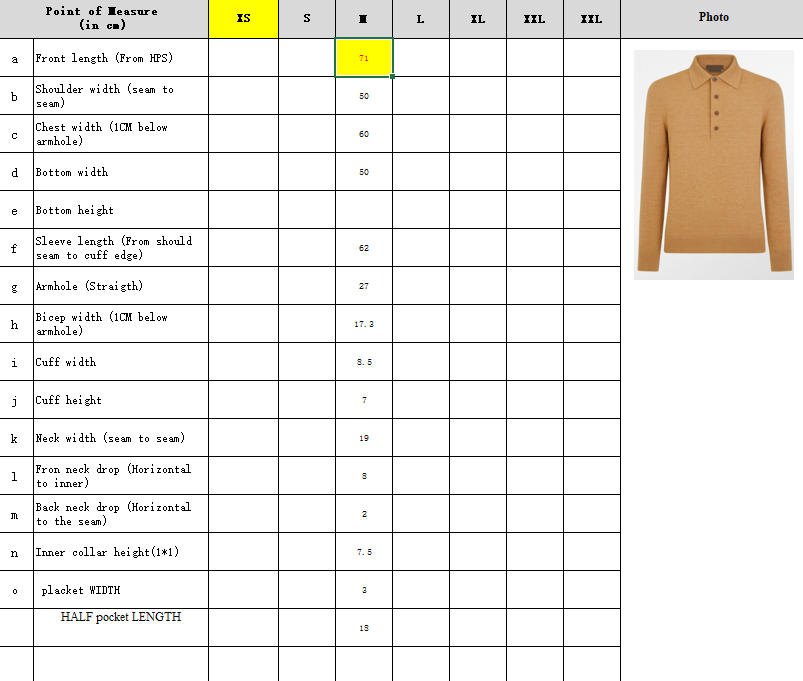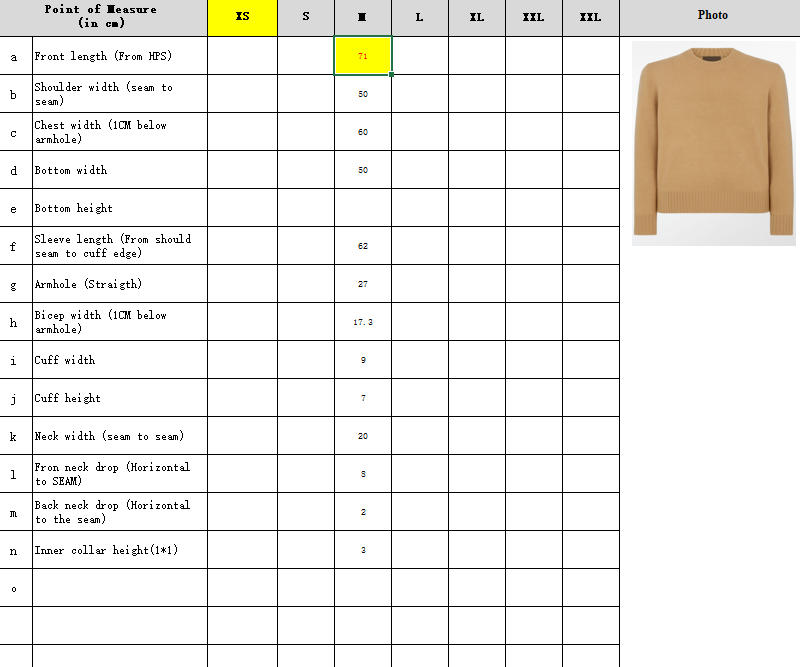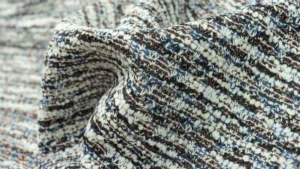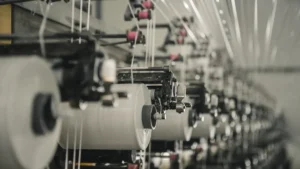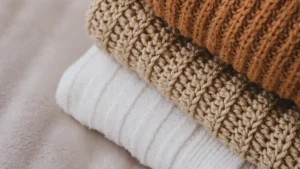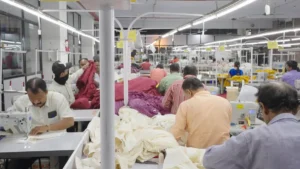Choosing the right sizing chart helps knitters make clothes that fit well. It also helps them feel comfortable. In 2025, big brands use at least six main sizing standards. These charts are for babies, children, women, men, head size, and hands or feet. Many knitters, from new to skilled, think sizing is confusing. They often have trouble matching their own tension. They also struggle with reading gauge patterns and picking the right needle size. A good knitwear Measurements guide can make things easier. It helps everyone get better results.
Key Takeaways
You need to measure your body to pick the right knitwear size. Always measure yourself with care. Then, match your numbers to the sizing chart.
Brands use different sizing charts and grading ways. These help fit many body shapes and styles. Always look at each brand’s chart before you buy or knit.
Positive ease means extra space in knitwear for comfort and style. Knowing how much ease you want helps you choose the best fit. You can pick from tight to oversized.
Inclusive sizing is better now. Many brands have more sizes. This helps more people find comfy and stylish clothes.
Swatching and checking gauge are important. Compare to your favorite clothes too. This helps your knitwear fit well and match your style and yarn.
Popular Sizing Charts
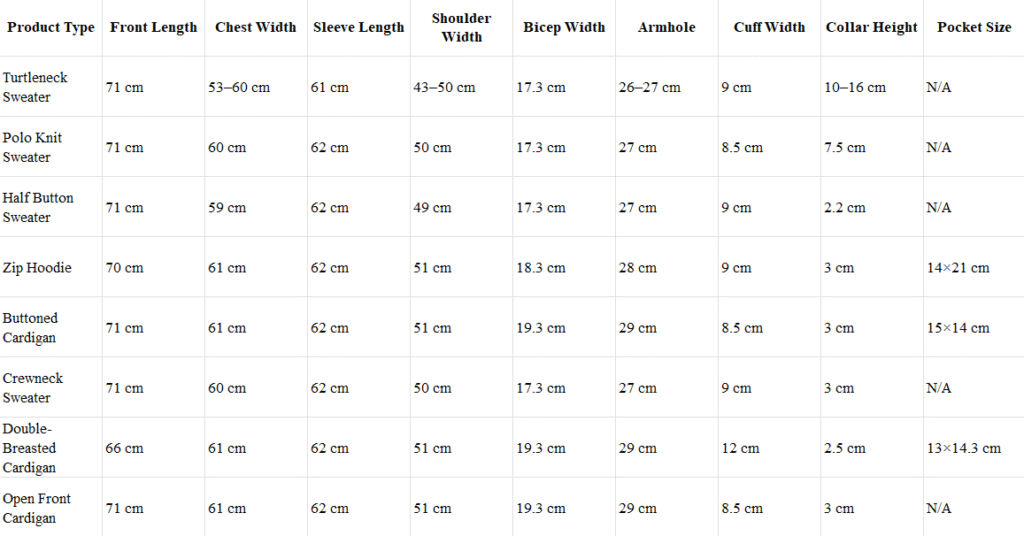
Leading Brands and Standards
Many knitwear brands in 2025 make their own sizing charts. They do this to fit different customers. Universal sizing does not work for everyone. People have different body shapes and styles. Brands change their charts often. This helps keep sizes right, especially for online shopping. Virtual fitting tools use these charts to help people pick sizes. Brands also try to keep sleeve and body lengths the same in each size. This makes it easier to change chunky knits or fitted styles.
Why These Charts Are Used
Brands want their fit and look to be special.
Sizing charts help customers trust the brand.
Each chart works for different body shapes and styles.
Brands update charts to match new trends and sizes.
Virtual fitting tools need the latest measurements to work well.
Knitwear sizing charts use gauge and body measurements. They do not just use garment size. This helps knitters change patterns for chunky yarns or tight fits.
Cardigan Size Charts
Cardigan size charts go from XS to 3X. They include both number and plus sizes. The difference between sizes is usually 1 to 3 inches. To get the best fit, measure while wearing layers like an undershirt. This works for both thick and thin cardigans.
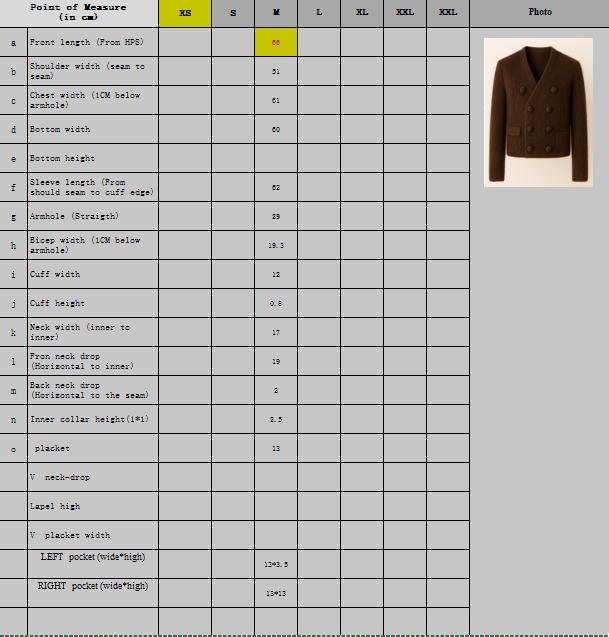
Half Zip Sweater Size Charts
Description / How to Measure | |
|---|---|
Chest / Bust | Measure flat across the chest one inch below the armhole. |
Sleeve Length | Measure from shoulder seam to cuff hem (or from center back). |
Body Length at Back | Measure from back collar seam down to hem edge. |
Charts for men, women, boys, and girls use these points. This makes it easy to compare sizes for different styles.
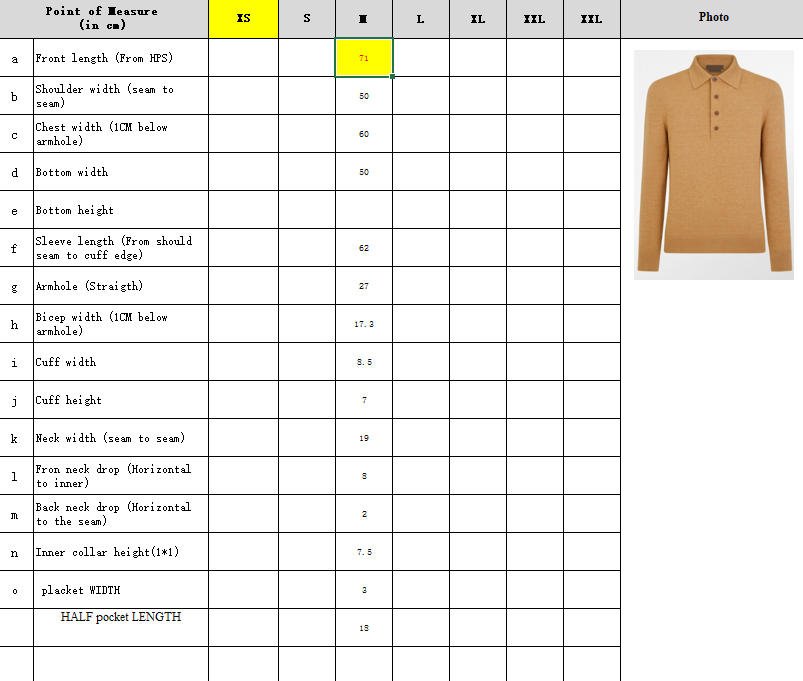
Full Zip Hoodies Size Charts
Full zip hoodie charts use body measurements to help with fit. Brands offer relaxed, slim, and regular fits. Stretchy fabrics and classic styles let you wear layers. The chart does not change for layering, but the fabric and fit do.
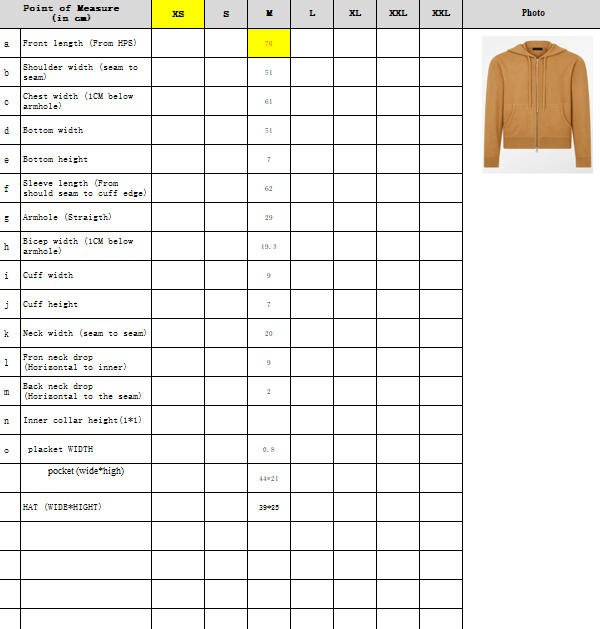
Pants Size Charts
Pants charts use waist size in inches, often as a range. Regular and tall pants can be up to 2 inches different in length. Charts show sizes for men, women, youth, and toddlers. They use real body measurements for better fit.
Polo Size Charts
Polo size charts show how fabric changes the fit. Cotton fits true to size. Polyester is more relaxed. DRI Fit fabrics are smaller.
Brands suggest ordering more large sizes.
There are many fit choices: tailored, classic, slim, and big/tall. This helps customers find the best fit for them.
Crewneck Sweater Size Charts
Crewneck sweater charts are different for each brand. Size names and fit styles are not the same, which can be confusing.
Ease means the space between your body and the sweater. Baggy fits can have 6 inches of ease. Fitted styles have about 1 inch.
Stretchy materials, like chunky wool, also change the fit.
Turtleneck Sweater Size Charts
Size | Chest (inches) | Length (inches) |
|---|---|---|
XS | 30 | 29.5 |
S | 32 | 30.25 |
M | 34 | 31 |
L | 36 | 31.75 |
XL | 38 | 32.5 |
2XL | 40 | 33.25 |
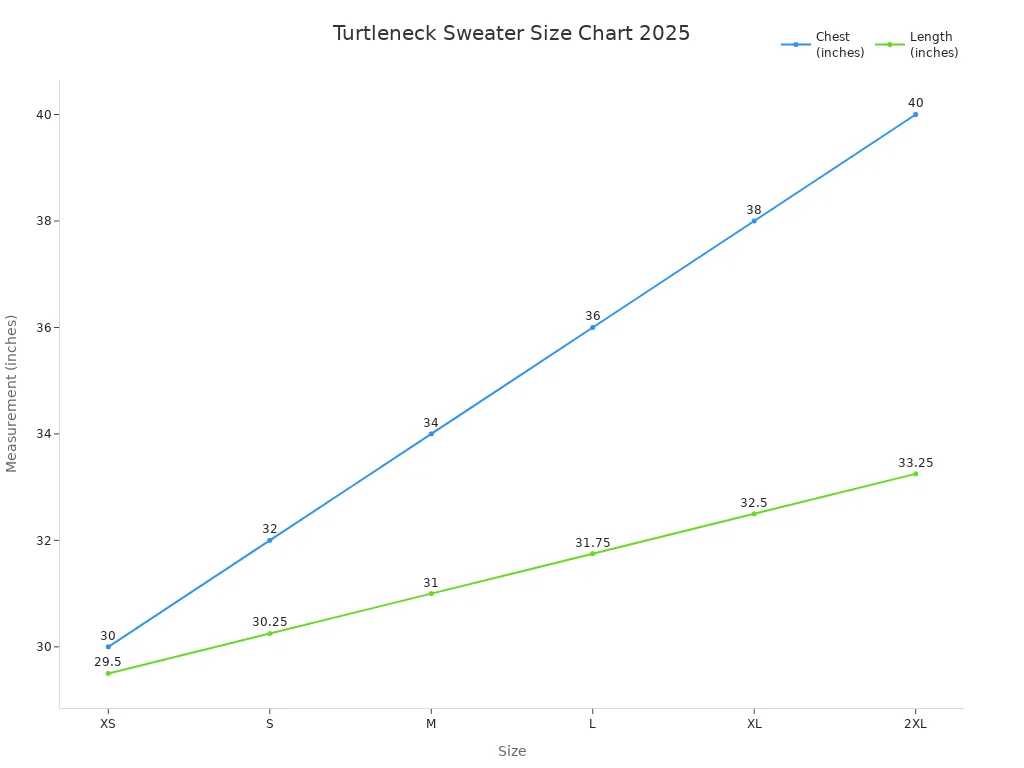
Turtleneck charts show chest and length. Neck fit is not measured but is included in the style. The sizing works for everyone. Women may pick a smaller size for a better fit.
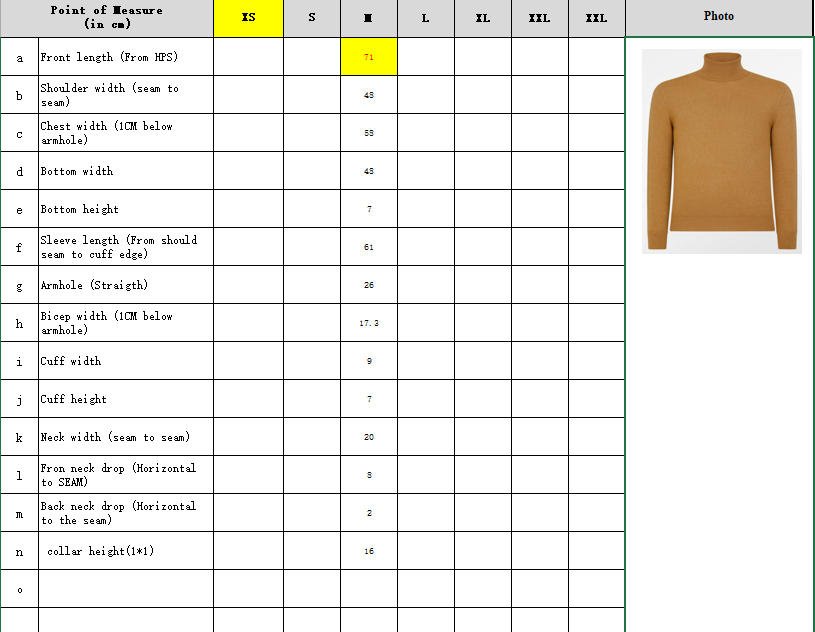
Knitwear Measurements Guide
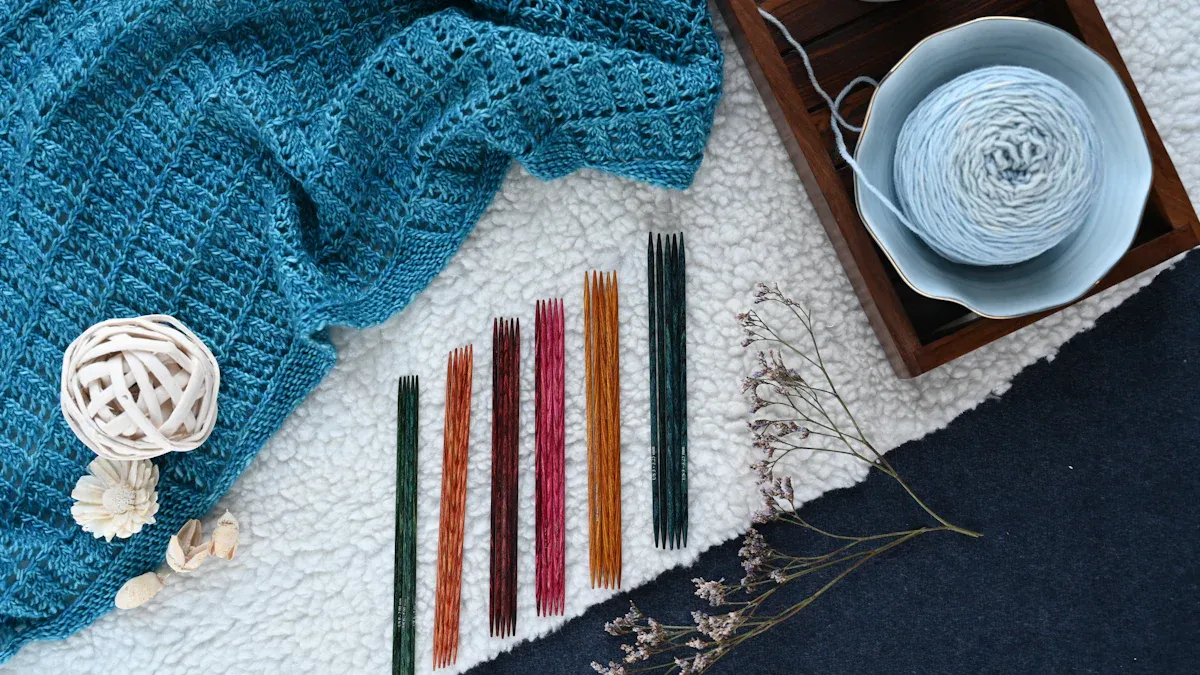
Key Body Measurements
A knitwear measurements guide helps people find the right fit. First, you need to measure your body carefully. Use a sweater you like to check chest, waist, and hips. Lay the sweater flat on a table. Measure from one armpit to the other for the chest. Double that number to get the chest size. Do the same for the waist and hips. Wear a shirt like what you will wear under the knitwear when you measure. This way works for both thick sweaters and thin tops.
Always use your current body measurements. Old numbers or guesses can make clothes fit badly. The guide says to write down all your measurements and how loose you want your clothes. Use a worksheet or chart to keep these notes safe for next time.
Positive Ease and Fit
Positive ease means the finished piece is bigger than your body. This extra space makes the clothes comfy and stylish. The guide says positive ease is needed for relaxed, classic, and oversized fits. Designers add positive ease at the bust, upper arms, hips, and armholes. This stops gaps and lets you wear layers, which is good for chunky knits.
Ease Type | Ease Amount (Bust/Chest) | Fit Description & Influence on Recommended Fit |
|---|---|---|
Very Close Fitting | 2″ to 4″ less than body measure | Negative ease creates a tight, form-fitting garment. |
Close Fitting | Equal to body measurement | Zero ease results in a snug fit. |
Classic Fit | Some positive ease gives a comfortable, relaxed fit. | |
Loose Fit | 4″ to 6″ more than body measure | More positive ease creates a loose, drapey silhouette. |
Oversized | 6+” more than body measure | Generous positive ease results in an oversized, relaxed style. |
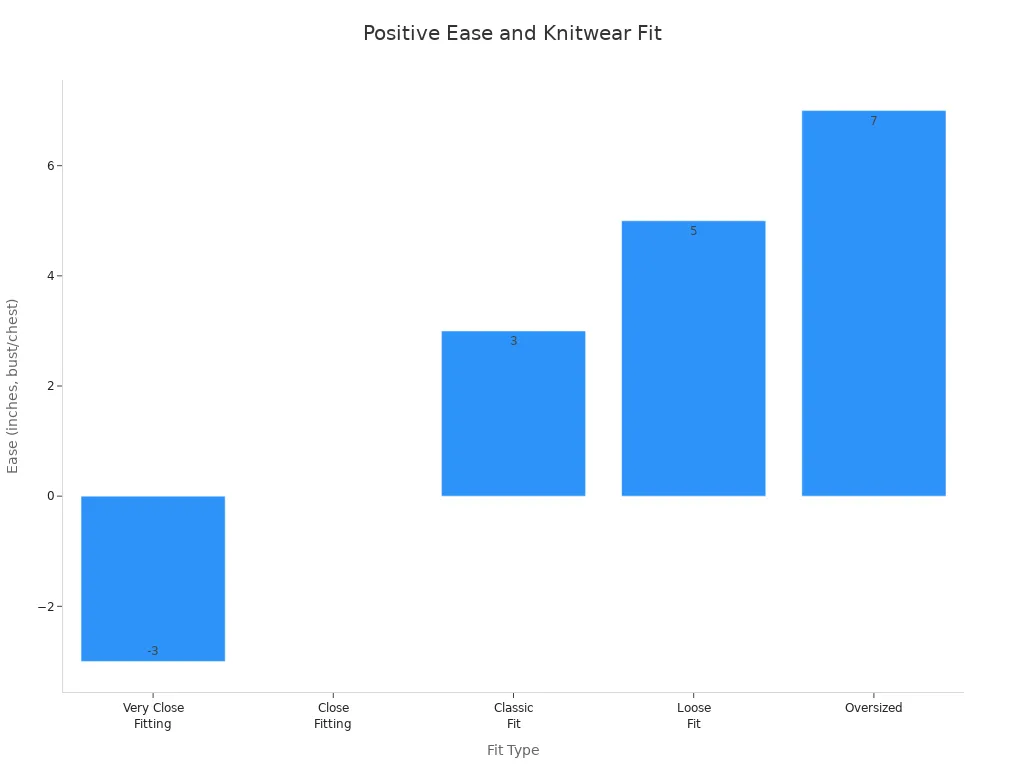
The guide shows that oversized styles need more positive ease. Chunky yarns also change how much ease feels good. Gauge, which is stitches and rows per inch, changes the final fit. Make a swatch before you start to check the size. Write down all your measurements and likes to help with future projects.
Sizing Chart Comparison
Measurement Differences
Knitwear brands use different methods to create their sizing chart. Ysolda, Rowan, and Bastian KNTWR each have their own approach. Some brands focus on body measurements, while others use garment measurements. For example, Ysolda’s patterns often include both bust and upper arm measurements. Rowan uses chest, waist, and hip measurements in most of its charts. Bastian KNTWR adds extra details for sleeve and body length, which helps knitters who want a better fit.
Grading hand knitting patterns means changing the pattern to fit many sizes. Designers use grading to make sure each size fits well. Some brands, like Donna Karan and Max Mara, use advanced grading for both slim and oversized styles. This helps their sweaters fit many body shapes. Chunky knits need special grading because thick yarn changes the way a sweater fits. A specific sizing chart for chunky sweaters will show more positive ease, so the garment does not feel too tight.
Unisex sizing charts use the same measurements for everyone. Brands like CYC and Big Bud Press use unisex charts for sweaters and hoodies. These charts often focus on chest and length. Gendered charts, like those from Max Mara or Donna Karan, use different measurements for men and women. This can make it harder to compare sizes between brands.
International sizing adds another layer of complexity. US, UK, and EU sizes do not match exactly. The Needle & Thread chart shows how a US size 0 matches a UK 4 and an EU 32. It also lists bust, waist, and hip measurements for each size. This helps knitters find the right fit when using patterns from other countries.
US Size | UK Size | EU Size | Bust (in) | Waist (in) | Hip (in) |
|---|---|---|---|---|---|
0 | 4 | 32 | 31 | 23.5 | 34.25 |
2 | 6 | 34 | 32 | 24.5 | 35.25 |
4 | 8 | 36 | 33 | 25.5 | 36.25 |
6 | 10 | 38 | 34 | 26.5 | 37.25 |
Tip: Always check your own measurements before using a sizing chart from another country. Labels can be confusing, but measurements give the best results.
Inclusivity and Range
Knitwear sizing has changed a lot since the early 2000s. Brands now offer more sizes to fit more people. In the past, most patterns only fit bust sizes from 30 to 40 inches. Today, many brands include sizes for busts from 28 up to 70 inches. This change happened because knitters asked for more inclusive options. Brands listened and updated their charts.
Some brands stand out for their size range and inclusivity. Big Bud Press offers sizes from XXS to 6XL. Loud Bodies goes even further, with sizes up to 10XL and free custom tailoring for unique measurements. EILEEN FISHER includes a plus collection that fits up to 3X. These brands use grading to make sure each size fits well, even for oversized or chunky styles.
Brand | Size Range | Key Features & Notes |
|---|---|---|
Big Bud Press | XXS to 6XL | American made, eco-friendly packaging, GOTS certified, unisex apparel, small business. |
Loud Bodies | XXS to 10XL | Eco-friendly, GOTS certified, made-to-order, free custom tailoring for atypical sizes, woman owned. |
EILEEN FISHER | Up to 3X | Sustainable materials, plus collection designed to be proportioned up to 3X, ethical and fair trade. |
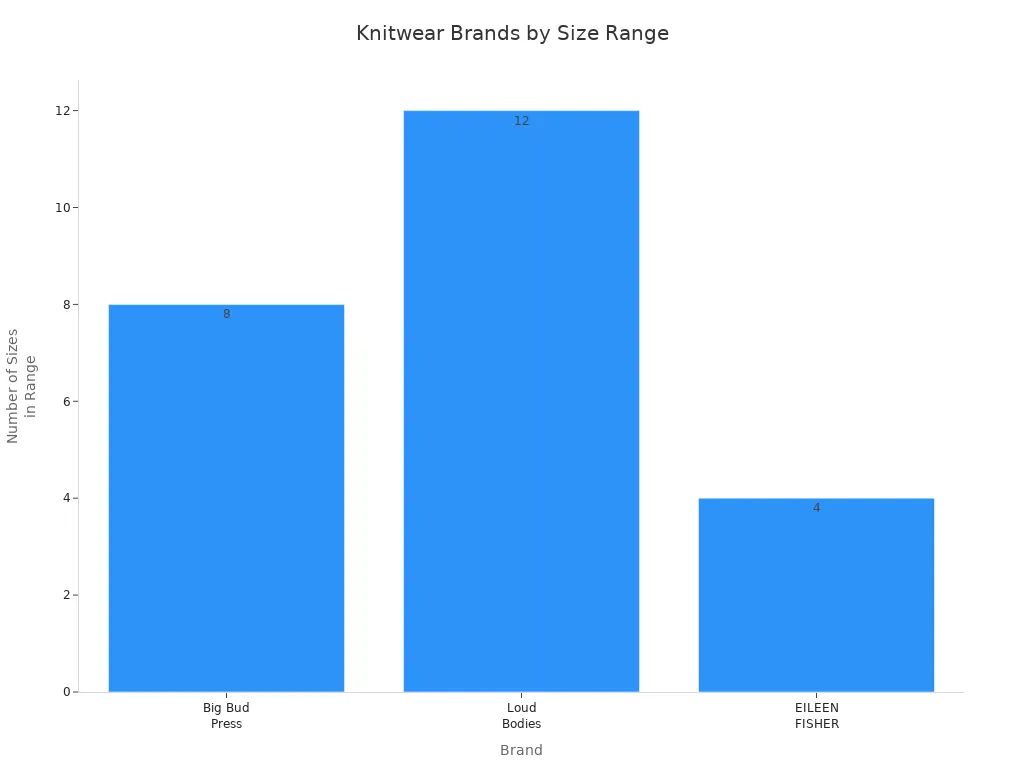
Grading helps brands offer more sizes without losing fit quality. Designers use grading to adjust patterns for both small and large sizes. Oversized and chunky sweaters need extra care during grading, so the final garment feels comfortable and looks good.
Note: Size-inclusive brands help everyone find knitwear that fits. They use detailed measurements and grading to make sure each person feels comfortable in their clothes.
Choosing the Right Chart
Factors to Consider
Picking the right knitwear sizing chart in 2025 is not simple. You need to think about more than just a size number. Many things can change how a sweater or cardigan fits. Knitters should remember these points:
Yarn type and stretch: Cotton and linen yarns do not stretch much. You might need a bigger size for these. Stretchy yarns, like spandex blends, let you wear a closer fit.
Ease and measurement type: Some charts use body measurements. Others use finished garment measurements. Knowing about ease helps you pick the right fit.
Accurate body measurements: Use a soft tape measure. Measure your bust, waist, hips, and other spots. Ask someone to help you for better results.
Sizing standards: Designers and countries use different sizing systems. Some use inches, others use centimeters. Always check which units the chart uses.
Plus size vs. regular size: Plus size charts use different fit models. These help clothes fit fuller bodies better.
International conversions: Size numbers are different in each country. Use conversion charts, but trust the designer’s chart and reviews most.
Designer sizing: Some brands use vanity sizing or special grading. This can make the fit different from other brands.
Key measurement: Focus on the most important body part for the item. For sweaters, look at the bust. For pants, check the hips.
Comfort and confidence: The right size should feel good and look nice. Do not pick clothes that are too tight or too loose.
Tip: Drummroll Knitwear and Elizabeth Smith Knits say to compare your own measurements to the chart. This helps you get a better fit.
Tips for Best Fit
Getting the best fit in knitwear takes some planning. Knitters can use these tips to get what they want:
Take Accurate Measurements
Always measure the fullest parts of your body. For sweaters, measure your chest or bust. For hats, measure around your head. Use a soft tape and write down your numbers.Understand Ease and Fit
Designers add ease to patterns for comfort. Positive ease means the garment is bigger than your body. Oversized styles use more ease for a relaxed look. Zero or negative ease makes a snug fit. Check if the chart uses finished garment or body measurements.Swatch and Check Gauge
Knit a swatch to check your gauge before you start. Small changes in stitches per inch can change the size. Change your stitch count if your gauge does not match the pattern.Compare to Existing Garments
Lay a favorite sweater flat and measure it. Compare these numbers to the chart. This helps you see how the new item will fit.Decide When to Size Up or Down
Size up if your bust or hips are bigger than the garment. This is important for long items or layering. Size down for a closer fit if the fabric is stretchy, like ribbed knits. Chunky yarns may need more ease for comfort. Grading helps change patterns for small and large sizes.Use Reliable Resources
Many places have updated or inclusive sizing charts:Public domain charts like ASTM standards, Alvanon, and Craft Yarn Council.
Knit & Crochet Guild sizing guides.
Custom charts from your own fitting experience.
Expert advice from Kim McBrien Evans and detailed charts from Ysolda.
Vendor charts from brands like Anthropologie, Boden, and J. Crew.
Online tools like Knit It Now and Knitty Blog for standard measurements.
Stay Informed and Share Experiences
Sizing charts change over time. Designers and brands update their grading for more body shapes. Sharing your feedback and stories helps make better patterns and charts.
Note: The best fit comes from good measurements, knowing about ease, and using the right chart for your yarn and style.
Popular knitwear sizing charts are not all the same. They use different measurements like cross back and armhole depth. These numbers can change how a sweater fits on you. The table below shows how these measurements are different:
Measurement Type | Regular Sizing (CYC) | ASTM Petite Misses | Kathleen Cheetham Petite Plus |
|---|---|---|---|
Cross Back (36″ bust) | 16″ – 16.5″ | 15″ | N/A |
Armhole Depth (36″ bust) | 7.5″ | 5 7/8″ | N/A |
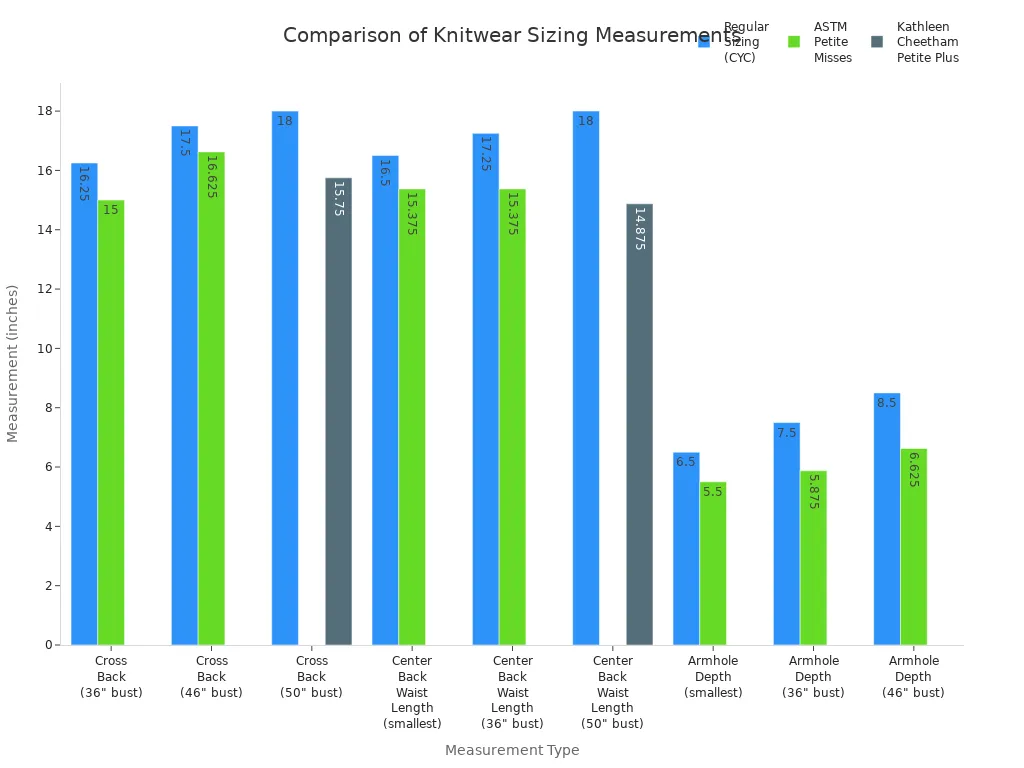
When sizes are not the same, sweaters might not fit right. This can make people upset and cause more returns. Shoppers can get better results by doing these things:
Check if the fabric stretches and let it rest before you measure.
Match your own measurements to each brand’s chart.
Trying out different charts can help you find what fits best. When people share what works, it helps everyone get better sizes.
FAQ
How does a knitwear measurements guide help with sizing?
A knitwear measurements guide tells you where to measure your body. It helps you match your numbers to the right sizing chart. This makes picking the right size for sweaters and cardigans easier.
Why do different brands use different sizing charts?
Brands use different sizing charts because people have many shapes. Each brand wants its clothes to fit in a special way. Some brands like oversized styles, while others use charts for chunky knits or slim fits.
What is grading hand knitting patterns?
Grading hand knitting patterns means changing a pattern to fit more sizes. Designers use grading to adjust the measurements for each size. This helps sweaters and other knitwear fit well, from small to big styles.
How do body measurements affect the fit of chunky knitwear?
Body measurements help you pick the right size for chunky knitwear. Chunky yarn makes sweaters bigger and heavier. Using the right chart and your measurements helps the sweater feel comfy and not too tight.
When should someone use an oversized sizing chart?
You should use an oversized sizing chart if you want a loose fit. Oversized charts add more space to the sweater. This style is good for chunky sweaters and for people who like extra room.

